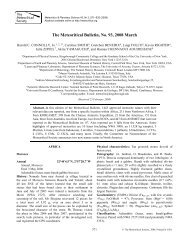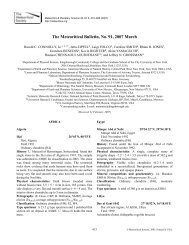Create successful ePaper yourself
Turn your PDF publications into a flip-book with our unique Google optimized e-Paper software.
562<br />
Table 1 Known lunar meteorites, as of early 2003.<br />
Meteorite Mass Pair total<br />
(g)<br />
a<br />
Rock type<br />
(g)<br />
b<br />
Year(s) c<br />
wt.% mol.%<br />
discovered Al2O3 mg<br />
Highland (and mostly highland) meteorites<br />
1 ALH81005 d<br />
31.4 31.4 Rego B, highland 1982 26 73<br />
2 Calcalong Creek 18 18 Rego B, mainly<br />
highland<br />
1991 21 ?<br />
3 Dar al Gani 262 513 513 Rego B, highland 1997 28 66<br />
4 Dar al Gani 400 1,425 1,425 Polymict B, highland 1998 28 71<br />
5 Dhofar 025 751 772 Rego B, highland 2000–2001 27 71<br />
paired samples Dhofars 301 (2 g), 304 (10 g), 308 (9 g)<br />
6 Dhofar 026 (13 stones) 636 636 Polymict B, highland 2000 27 71<br />
7 Dhofar 081 174 564 Polymict B, highland 1999–2001 31 61<br />
paired samples Dhofars 280 (251 g), 302 (3.8 g), 303 (4.1 g), 305 (34), 306 (13), 307 (50), 490 (34)<br />
8 Dhofar 489 34.4 34.4 Polymict B, highland 2001 30 (est.) ?<br />
9 MAC88104 61 723 Rego B, highland 1989 28 63<br />
paired sample MAC88105 (662 g)<br />
10 NWA482 1,015 1,015 IMB, highland 2001 29 66<br />
11 QUE93069 21.4 24.5 Rego B, highland 1994–1995 28 66<br />
paired sample QUE94269 (3.1 g)<br />
12 Yamato-791197 52 341 Rego B, highland 1983–2002 26 63<br />
paired (???) sample Yamato-983885 (289 g)<br />
13 Yamato-82192 37 712 Polymict B, highland 1984–1987 28 66<br />
paired samples Yamato-82193 (27 g), Yamato-86302 (648 g)<br />
Mare (and mostly mare) meteorites<br />
1 Asuka-881757 442 442 Gabbro, mare 1990 11 33<br />
2 Dhofar 287 154 154 Basalt þ Rego B, mare 2001 8 50<br />
3 EET87521 31 84 Polymict B, mare 1989–1998 13 42<br />
paired sample EET96008 (53 g)<br />
4 NWA032 300 456 Basalt, mare 2000 9 40<br />
paired sample NWA479 (156 g)<br />
5 NWA773 (3 stones) 633 633 Gabbro þ Rego B, mare 2001 6 70<br />
6 QUE94281 23.4 23.4 Rego B, mainly mare 1995 16 52<br />
7 Yamato-793169 6.1 6.1 Basalt, mare 1990 12 31<br />
8 Yamato-793274 8.7 195 Rego B, mainly mare 1987–1999 15 53<br />
paired sample Yamato-981031 (186 g)<br />
a<br />
Aside from the conventional pairings noted in the table, several launch pairs have been inferred: Yamato-793169 with Asuka-881757, and<br />
QUE94281 with Yamato-793274 (and possibly also with EET87521) (Arai and Warren, 1999; Korotev et al., 2003). <strong>The</strong>re may be other<br />
b<br />
launch pairs that are not manifested (i.e., the rocks are not sufficiently ideosyncratic). Abbreviations: Rego, regolith; B, breccia; IMB, impact-melt<br />
breccia. <strong>The</strong> classification “polymict breccia” for six of the samples may seem vague, but most of these six samples are either difficult to classify or<br />
c<br />
simply little-studied. EET87521 is clearly a fragmental breccia. Listed “discovery” dates refer to year of discovery of lunar provenance, not<br />
year sample was first collected as a meteorite. d Samples shown in bold font are from Antarctica, and thus generally less weathered than the other<br />
(hot-desert) finds.<br />
the meteorites hitting Earth in modern times; only<br />
glasses (tektites) are known to have re-entered<br />
from space. In any case, to date no “retrometeorite”<br />
has been found among the lunar samples.<br />
<strong>1.21</strong>.2.3 Remote-sensing Data<br />
<strong>The</strong> period since the early 1990s has been a<br />
golden age for lunar remote sensing, thanks to the<br />
1994 Clementine mission and the 1997–1998<br />
Lunar Prospector mission. Among the pre-1994<br />
remote-sensing geochemical databases, the most<br />
notable (i.e., still not completely superceded) is<br />
probably the X-ray spectrometry data obtained for<br />
,10% of the lunar surface on the Apollo 15 and<br />
16 missions. <strong>The</strong>se data were reported as Al/Si,<br />
Mg/Al, and Mg/Si ratios, at a spatial resolution of<br />
<strong>The</strong> <strong>Moon</strong><br />
,50 km (e.g., Adler et al., 1973; Bielefeld et al.,<br />
1977; Andre and El-Baz, 1981). <strong>The</strong> more<br />
precisely determined Al/Si ratio data show trends<br />
that could be gleaned almost as well from simple<br />
albedo variations. Among lunar rocks, aluminum<br />
is strongly linked with light-colored feldspar,<br />
while silicon is relatively constant (probably as a<br />
consequence of the lesser potential to form<br />
silicon-free oxides, except “late” ilmenite, in the<br />
reducing lunar environment). <strong>The</strong> Mg/Si and Mg/<br />
Al data suffer from poor precision. For example,<br />
the average 1s error in Mg/Si reported for 22 large<br />
regions by Adler et al. (1973) is 26%.<br />
Clementine used four different cameras to map<br />
the global surface reflectance of the <strong>Moon</strong> at<br />
eleven different wavelengths, from the nearultraviolet<br />
(415 nm) to the near-infrared<br />
(2,800 nm), in roughly one million images.





